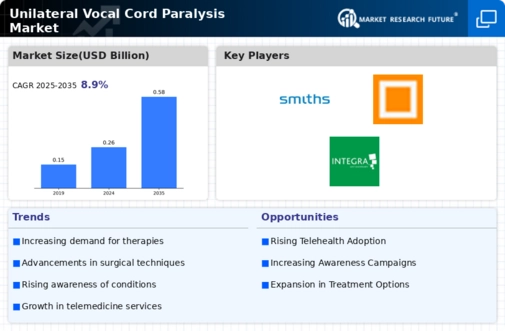Market Analysis
In-depth Analysis of Unilateral Vocal Cord Paralysis Market Industry Landscape
Incidence and Prevalence : UVCP is a relatively common condition, with an estimated annual incidence of 5.4 cases per 100,000 individuals, affecting both genders equally, and typically seen in middle-aged to older adults.
Etiology and Risk Factors : The leading causes of UVCP include surgical trauma, particularly thyroid or anterior cervical spine surgery, as well as viral infections, trauma to the neck or chest, and neurological disorders such as stroke or tumors. Other risk factors include advanced age and male gender.
Symptoms and Clinical Presentation : Patients with UVCP often present with dysphonia, breathiness, hoarseness, and difficulty projecting their voice. Dysphagia and aspiration pneumonia may also occur due to impaired vocal cord function, leading to complications in swallowing.
Diagnostic Approaches : Diagnosis typically involves a thorough medical history, physical examination, and laryngoscopy to visualize vocal cord movement. Additional tests such as electromyography (EMG), imaging studies like CT or MRI scans, and pulmonary function tests may be performed to determine the underlying cause and assess vocal cord function.
Treatment Modalities : Management strategies for UVCP aim to improve voice quality, prevent aspiration, and address underlying etiologies. Options include speech therapy to optimize vocal cord function, surgical interventions such as vocal cord medialization or reinnervation procedures, and in some cases, botulinum toxin injections to temporarily paralyze the unaffected vocal cord and restore balance.
Market Trends and Forecast : The market for UVCP treatments is expected to witness steady growth due to an aging population and increasing awareness of the condition. Technological advancements in diagnostic imaging and surgical techniques may further drive market expansion, offering more precise and minimally invasive treatment options.
Key Players and Competitive Landscape : Pharmaceutical companies, medical device manufacturers, and healthcare providers play integral roles in the UVCP market. Key players include companies specializing in laryngeal implants, neuromodulation devices, and voice therapy services. Competition within the market fosters innovation and the development of novel treatment modalities.
Challenges and Opportunities : Despite advancements in treatment options, challenges such as limited access to specialized care and variability in treatment outcomes persist. Opportunities for market growth lie in the development of targeted therapies addressing specific etiologies of UVCP, as well as the expansion of telemedicine services to improve patient access to expert care.
Regulatory Landscape and Reimbursement Policies : Regulatory approvals and reimbursement policies influence market dynamics by shaping the availability and affordability of UVCP treatments. Compliance with regulatory standards and demonstration of clinical efficacy are crucial for market entry and reimbursement approval.
Patient Education and Support : Empowering patients with knowledge about UVCP, its management, and available resources is essential for improving treatment outcomes and quality of life. Patient support groups and educational initiatives contribute to raising awareness and fostering a supportive community for individuals living with UVCP.


















Leave a Comment